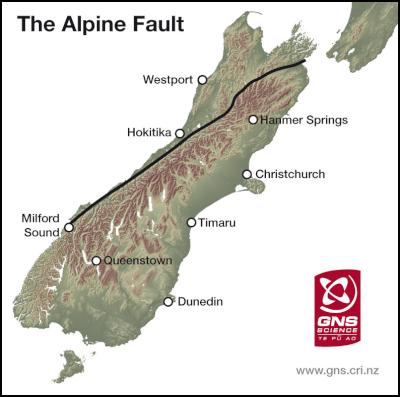Plan To Drill Into Fault To Study Earthquakes
Scientists Plan To Drill Into Fault To Study Earthquakes

Click to enlarge
NEWS RELEASE
18 JULY
2008
SCIENTISTS PLAN TO DRILL INTO FAULT TO STUDY
EARTHQUAKES
A group of New Zealand and international scientists has been awarded funding to investigate drilling into the Alpine Fault on the West Coast of the South Island, so they can learn about earthquakes and how the fault operates.
Leader of the group, John Townend from Victoria University of Wellington, said that funding of US$44,500 from the International Continental Scientific Drilling Programme would be used to convene a group of geologists and geophysicists who had recognised that the Alpine Fault was a globally unique natural laboratory for studying earthquake processes.
Dr Townend said the project would build on recent international experience and technological advances in scientific drilling to understand earthquakes.
Co-leader, Rupert Sutherland from GNS Science, said the Alpine Fault last ruptured in 1717 producing an earthquake of about magnitude 8 that would have strongly shaken the whole South Island.
Dr Sutherland said another large earthquake on the Alpine Fault could strike this century, and the international funding provided an outstanding opportunity to better understand and monitor the South Island’s most dangerous fault.
Some of the world’s leading earth scientists would come to New Zealand in early 2009 to help formulate plans for the long-term project, Dr Sutherland said.
ENDS
Background
information:
The Alpine Fault runs about 650km up the
spine of the South Island between Milford Sound and
Marlborough. It is the on-land boundary between the Pacific
and Australian tectonic plates. It moves a total of about
27m horizontally every 1000 years, in three or four separate
ruptures each producing an earthquake of about magnitude
7.9. In between major ruptures, it does not move at the
surface.
It is a globally significant fault that is thought to rupture every 200-400 years and last ruptured in 1717. The two tectonic plates that meet at the Alpine Fault are moving past and pushing against each other and this forces the Southern Alps higher. It also uplifts rocks from deep within the Earth’s crust. By drilling deep into the crust, researchers hope to sample these rocks which are young (less than 1 million years old) and from the zone where earthquakes occur.
By comparing rocks retrieved by drilling with rocks exposed at the surface, the research team hopes to discover how the Earth’s crust deforms during earthquakes. They also hope to learn about chemical and physical changes occurring at various depths.
Funding for this project was awarded after a team of New Zealand and international researchers led by John Townend (Victoria University of Wellington) and Rupert Sutherland (GNS Science) submitted a proposal to the International Continental Scientific Drilling Programme (ICDP) in early 2008, outlining their proposal to drill into the Alpine Fault.
The ICDP funding will cover costs of a five-day international workshop to be held in New Zealand in early 2009, at which scientists with expertise in a broad range of fields will plan a programme of site characterisation and deep drilling into the central Alpine Fault. The central Alpine Fault refers to a 280km section of the fault between Haast and Hokitika.


 John Mazenier: Gaffer Tape And Glue Delivering New Zealand’s Mission Critical Services
John Mazenier: Gaffer Tape And Glue Delivering New Zealand’s Mission Critical Services Earthquake Commission: Ivan Skinner Award Winner Inspired By Real-life Earthquake Experience
Earthquake Commission: Ivan Skinner Award Winner Inspired By Real-life Earthquake Experience Reserve Bank: Consultation Opens On A Digital Currency For New Zealand
Reserve Bank: Consultation Opens On A Digital Currency For New Zealand NIWA: Ship Anchors May Cause Extensive And Long-lasting Damage To The Seafloor, According To New Research
NIWA: Ship Anchors May Cause Extensive And Long-lasting Damage To The Seafloor, According To New Research New Zealand Customs Service: A Step Forward For Simpler Trade Between New Zealand And Singapore
New Zealand Customs Service: A Step Forward For Simpler Trade Between New Zealand And Singapore Horizon Research: 68% Say Make Banks Offer Fraud Protection
Horizon Research: 68% Say Make Banks Offer Fraud Protection



